sensor ASTON MARTIN DB7 1997 Owner's Manual
[x] Cancel search | Manufacturer: ASTON MARTIN, Model Year: 1997, Model line: DB7, Model: ASTON MARTIN DB7 1997Pages: 421, PDF Size: 9.31 MB
Page 172 of 421

NO COLOUI 766 NO 656 NG
1192 BU 1193 BG 1194 BO 1195 BY 1196 6R 1197 BK 1198 8W 1199 BS 1200 B 1201 B 645 m
763 GB 726 RB 1202 8
765 0
PIN 1 2 3 4 S 6 7 B 9 10 II 12 13 14 15 16 17 18 19 20 21 22 23 24 25 26 27 2B
AREA 20.A4 20.A4
20.03 20.03 20.02 20.02 20.C6 20.C6 20.B6 20.86 20.82 20.82 20.45
20.45 20.45 20.82
20.45
(^
NO
COLOUR
PIN
4RE4
656 NG
I 20.41
766 NO
2 20.41
3
SHEET
10 AREA^'i
NO 763
764 726 645 765
COLOUR
GB
BY RB m 0
PIN
1 2
3 4 5
6 7 8
ARE4
20.41
20.83
20.81 20.41 20.41
BULKHEAD SHOWN BULKHEAD
RED
NO
COLOUR
PIN
764
BY 1
1203
8 2
AREA 20.45 20.82
RESERVIOR SENSOR
HO
COLOUR
1200
8
1201
B
1202
B
1203
8
AREA
20.
Al
20.
Al
20.BI 20.83
J?;
^L
p[[CTJo
C3
CD CD en 5
A
CD CD CD C3 1
NO
COLOUR
PIN
AREA
I 1198
8W
2
1199
BS
3
20.
Al 20.41
REAR
R.H.
SENSOR
i
REAR
L.H.
SENSOR
NO
COLOUR
PIN
4REA
1196
BR
2
1197 BK
3
20.
Al
20.
Al
FRONT
R.H.SENSOR
FRONT
L.H.
SENSOR
NO
COLOUR
PIN
AREA
I 1194
80 2 20.41
1195
BY
3 20.41
NO
COLOUR
PIN
I 1192
8U
2
1193
BG
3
20.
Al 20.41
[D:m^-^ Wiring Diagram
Model - Aston Martin DB7
Harness Title-ABS-LHD
Part No. - B37-84645
Revision - 0 Sheet 20 of 26 - 97 MY
Page 187 of 421
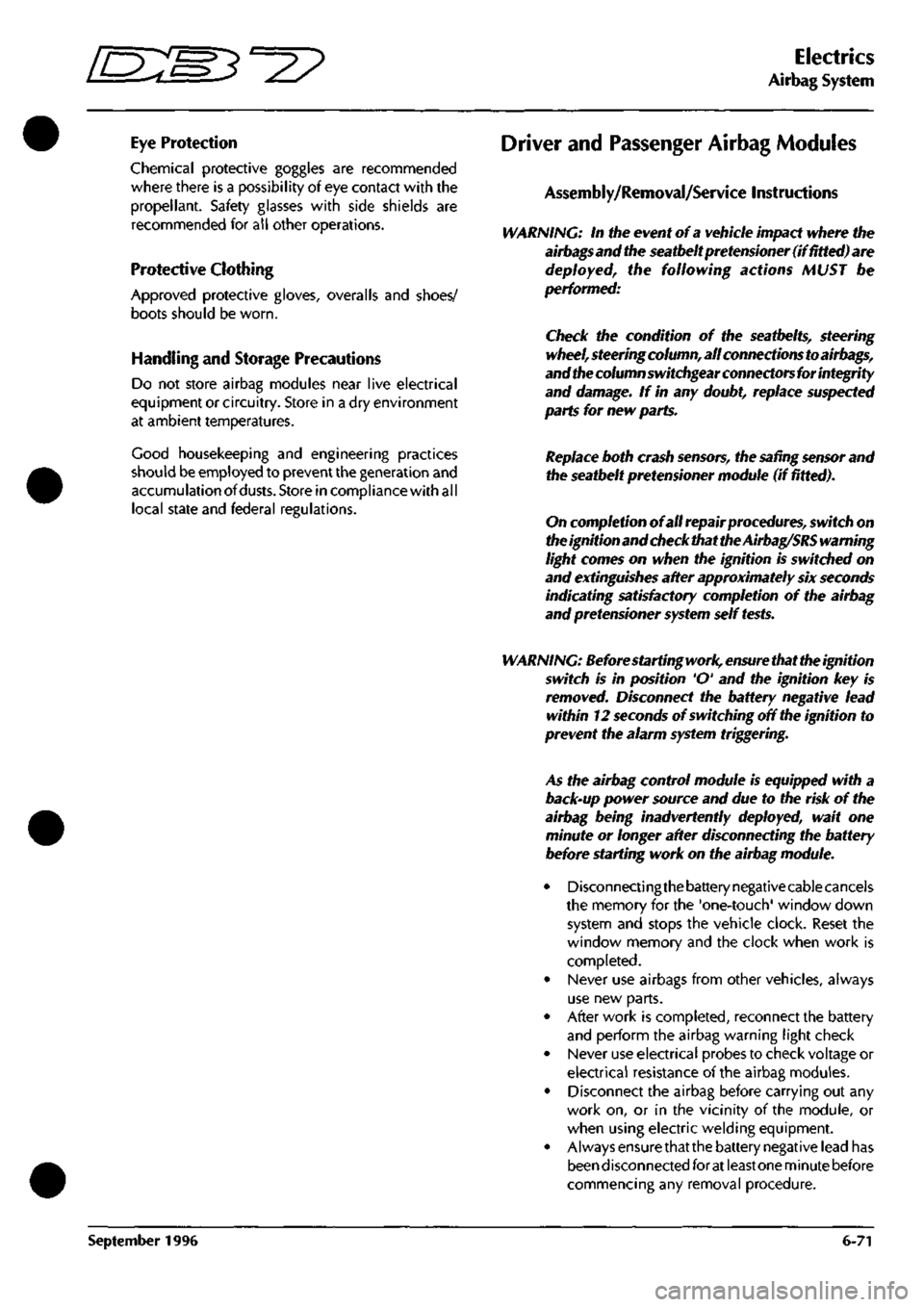
^=2?
Electrics
Airbag System
Eye Protection
Chemical protective goggles are recommended
where there is a possibility of eye contact with the
propellant. Safety glasses with side shields are
recommended for all other operations.
Protective Clothing
Approved protective gloves, overalls and shoes/
boots should be worn.
Handling and Storage Precautions
Do not store airbag modules near live electrical
equipment or circuitry. Store in a dry environment
at ambient temperatures.
Good housekeeping and engineering practices
should be employed to prevent the generation and
accumulation of
dusts.
Store in compliance with all
local state and federal regulations.
Driver and Passenger Airbag Modules
Assembly/Removal/Service Instructions
WARNING: In the event of a vehicle impact where the
airbags and the seatbeltpretensioner (if fitted) are
deployed, the following actions MUST be
performed:
Check the condition of the seatbelts, steering
wheel,
steering column, all connections to airbags,
and the column switchgear connectors for integrity
and damage. If in any
doubt,
replace suspected
parts for new parts.
Replace both crash
sensors,
the
safing sensor
and
the seatbelt pretensioner module (if fitted).
On completion of all repair procedures, switch on
the ignition and check that the
Airbag/SRS
warning
light comes on when the ignition is switched on
and extinguishes after approximately six seconds
indicating satisfactory completion of the airbag
and pretensioner
system
self
tests.
WARNING: Before starting
work,
ensure
that the ignition
switch is in position 'O' and the ignition key is
removed.
Disconnect the battery negative lead
within 12 seconds of switching off the ignition to
prevent the alarm system triggering.
As the airbag control module is equipped with a
back-up power source and due to the risk of the
airbag being inadvertently deployed, wait one
minute or longer after disconnecting the battery
before starting work on the airbag module.
• Disconnectingthe battery negative cable cancels
the memory for the 'one-touch' window down
system and stops the vehicle clock. Reset the
window memory and the clock when work is
completed.
• Never use airbags from other vehicles, always
use new parts.
• After work is completed, reconnect the battery
and perform the airbag warning light check
• Never use electrical probes to check voltage or
electrical resistance of the airbag modules.
• Disconnect the airbag before carrying out any
work on, or in the vicinity of the module, or
when using electric welding equipment.
• Always ensure that the battery negative lead has
been disconnected for at least one minute before
commencing any removal procedure.
September 1996 6-71
Page 192 of 421
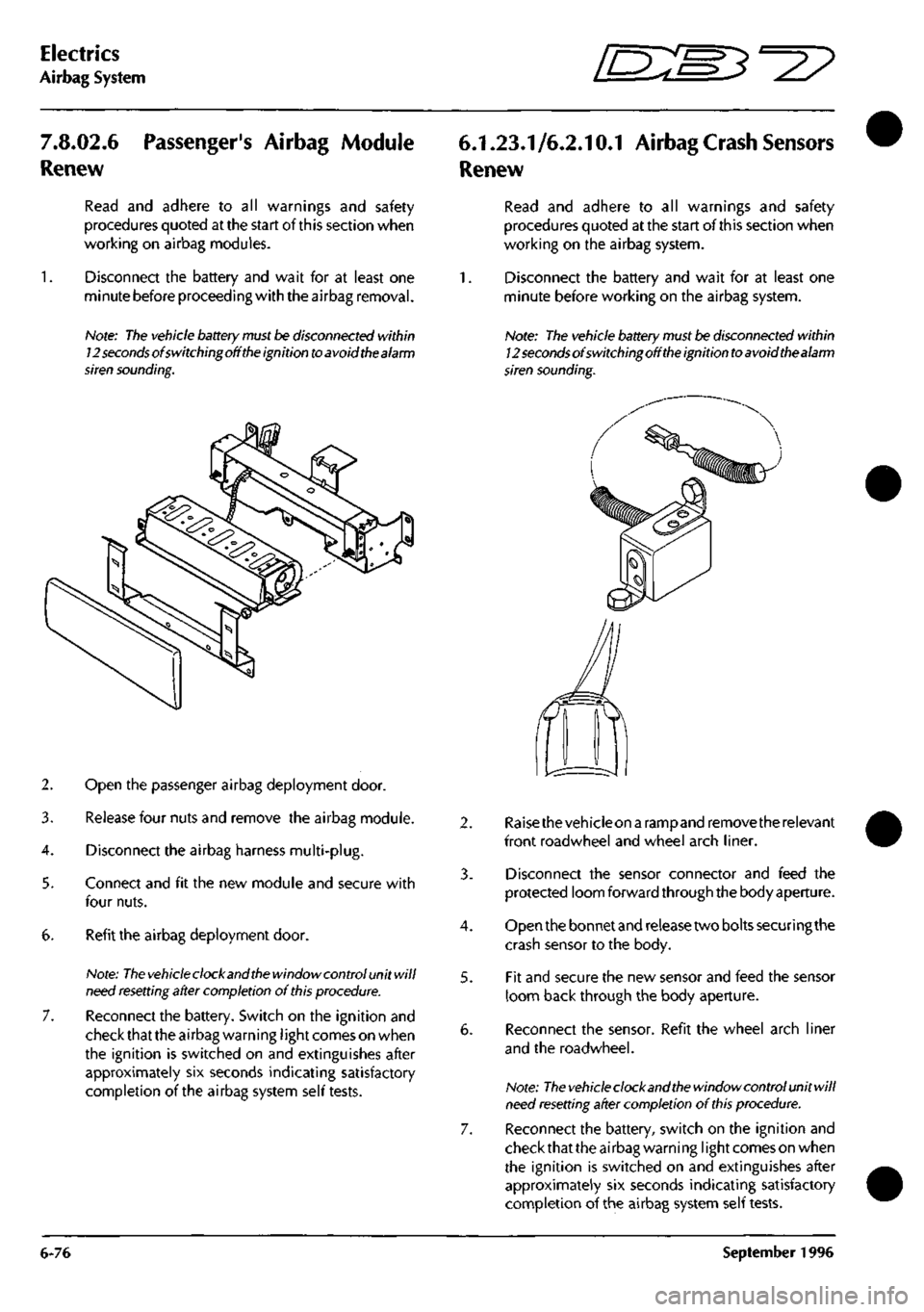
Electrics
Airbag System ^^?
7.8.02.6
Renew
Passenger's Airbag Module
Read and adhere to all warnings and safety
procedures quoted at the start of this section when
working on airbag modules.
Disconnect the battery and wait for at least one
minute before proceeding with the airbag removal.
Note:
The
vehicle battery
must
be disconnected within
12
seconds
of switchingoff
the
ignition
to
avoid the alarm
siren sounding.
2. Open the passenger airbag deployment door.
3. Release four nuts and remove the airbag module.
4.
Disconnect the airbag harness multi-plug.
5. Connect and fit the new module and secure with
four nuts.
6. Refit the airbag deployment door.
Note:
The vehicle
clock and
the
window control unit will
need
resetting
after completion of
this
procedure.
7. Reconnect the battery. Switch on the ignition and
check that the airbag warning
I
ight comes on when
the ignition is switched on and extinguishes after
approximately six seconds indicating satisfactory
completion of the airbag system self tests.
6.1.23.1/6.2.10.1 Airbag
Crash
Sensors
Renew
Read and adhere to all warnings and safety
procedures quoted at the start of this section when
working on the airbag system.
1.
Disconnect the battery and wait for at least one
minute before working on the airbag system.
Note: The vehicle
battery
must be disconnected within
12
seconds
of switchingoff
the
ignition
to
avoid thealarm
siren sounding.
4.
5.
Raisethevehicleon a rampand remove the relevant
front roadwheel and wheel arch liner.
Disconnect the sensor connector and feed the
protected loom forward through the body aperture.
Open the bonnet and release two bolts securing the
crash sensor to the body.
Fit and secure the new sensor and feed the sensor
loom back through the body aperture.
Reconnect the sensor. Refit the wheel arch liner
and the roadwheel.
Note:
The vehicle
clock and
the
window control unit will
need
resetting
after completion of
this
procedure.
Reconnect the battery, switch on the ignition and
check that the airbag warning
I
ight comes on when
the ignition is switched on and extinguishes after
approximately six seconds indicating satisfactory
completion of the airbag system self tests.
6-76 September 1996
Page 193 of 421
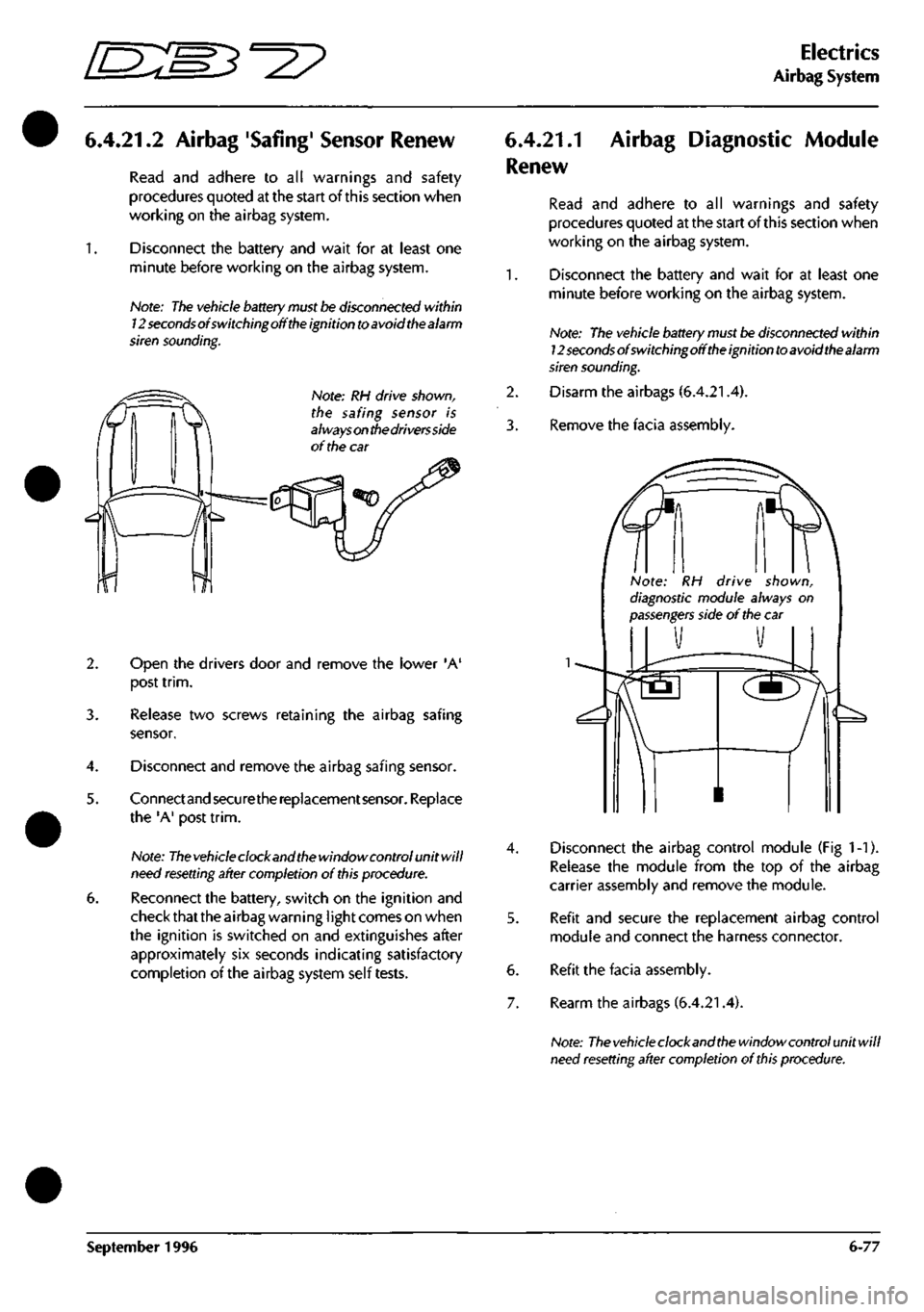
^7
Electrics
Airbag System
6.4.21.2
Airbag 'Safing' Sensor Renew
Read and adhere to all warnings and safety
procedures quoted at the start of this section when
working on the airbag system.
1.
Disconnect the battery and wait for at least one
minute before working on the airbag system.
Note:
The
vehicle battery must be disconnected within
12 secondsofswitchingoffthe ignition to avoid the alarm
siren sounding.
^h
Note: RH drive shown,
the safing sensor is
always
on
the drivers side
of the car
2. Open the drivers door and remove the lower 'A'
post
trim.
3. Release two screws retaining the airbag safing
sensor.
4.
Disconnect and remove the airbag safing sensor.
5. Connectand securethe replacement sensor. Replace
the 'A' post
trim.
Note:
The
vehicle clock and
the
window control unit will
need
resetting
after completion of
this
procedure.
6. Reconnect the battery, switch on the ignition and
check that the airbag warning
I
ight comes on when
the ignition is switched on and extinguishes after
approximately six seconds indicating satisfactory
completion of the airbag system self tests.
6.4.21.1
Renew
Airbag Diagnostic Module
1.
2.
3.
4.
6.
7.
Read and adhere to all warnings and safety
procedures quoted at the start of this section when
working on the airbag system.
Disconnect the battery and wait for at least one
minute before working on the airbag system.
Note: The vehicle battery must
be
disconnected within
l2secondsofswitchingofftheignitiontoavoidthealarm
siren
sounding.
Disarm the airbags (6.4.21.4).
Remove the facia assembly.
Note: RH drive shown,
diagnostic module always on
passengers
side of
the
car
Disconnect the airbag control module (Fig 1-1).
Release the module from the top of the airbag
carrier assembly and remove the module.
Refit and secure the replacement airbag control
module and connect the harness connector.
Refit the facia assembly.
Rearm the airbags (6.4.21.4).
Note:
The
vehicle clock and
the
window control unit will
need
resetting
after completion of this procedure.
September 1996 6-77
Page 194 of 421
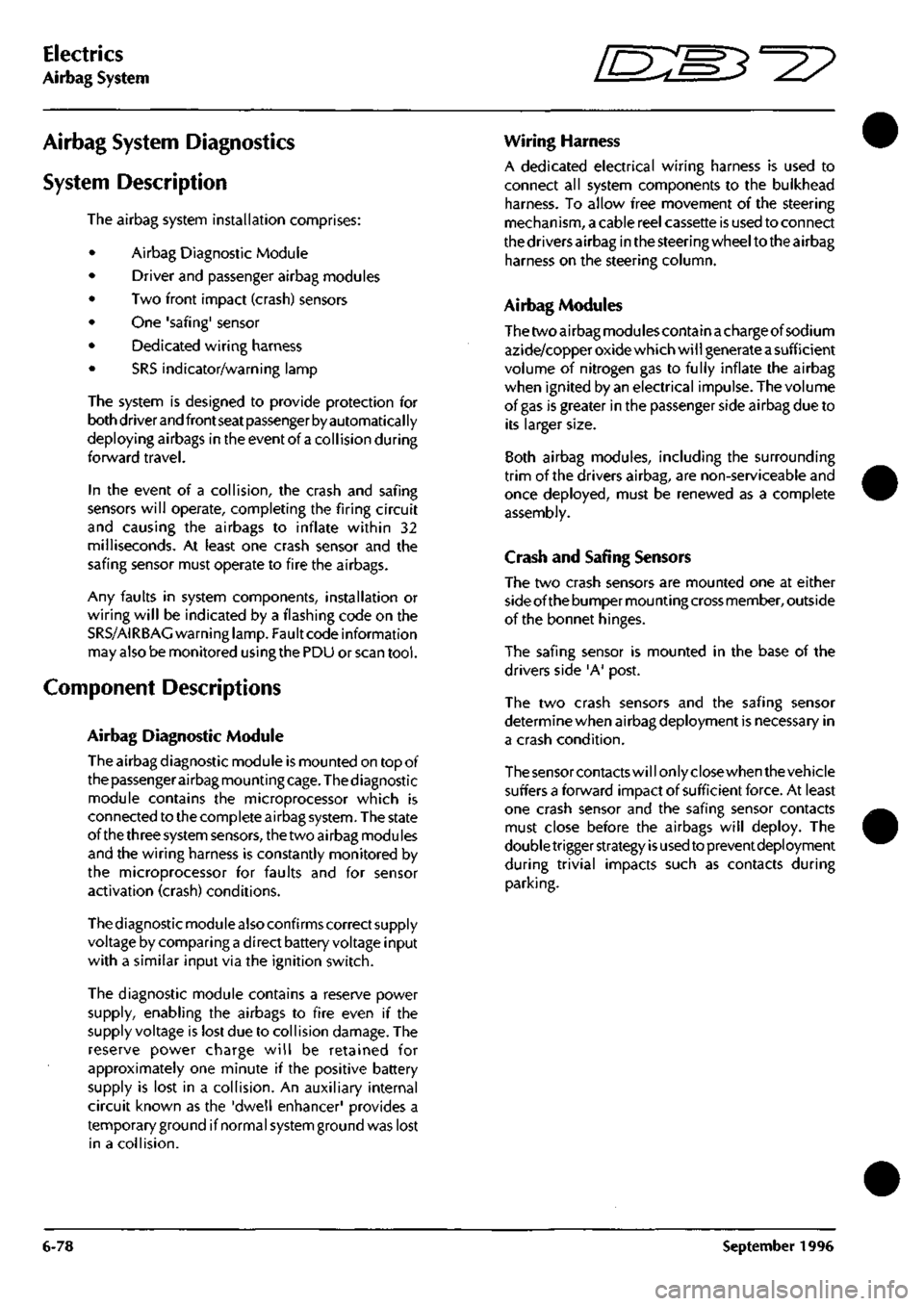
Electrics
Airbag System '=2?
Airbag System Diagnostics
System Description
The airbag system installation comprises:
Airbag Diagnostic Module
Driver and passenger airbag modules
Two front impact (crash) sensors
One 'safing' sensor
Dedicated wiring harness
SRS indicator/warning lamp
The system is designed to provide protection for
both driver and front seat passenger by automatical ly
deploying airbags in the event of
a
collision during
forward travel.
In the event of a collision, the crash and safing
sensors will operate, completing the firing circuit
and causing the airbags to inflate within 32
milliseconds. At least one crash sensor and the
safing sensor must operate to fire the airbags.
Any faults in system components, installation or
wiring will be indicated by a flashing code on the
SRS/AIRBAG warning lamp. Fault code information
may also be monitored using the PDU or scan
tool.
Component Descriptions
Airbag Diagnostic Module
The airbag diagnostic module is mounted on top of
the passenger airbag mountingcage.Thediagnostic
module contains the microprocessor which is
connected to the complete airbag system. The state
of the three system sensors, the two airbag modules
and the wiring harness is constantly monitored by
the microprocessor for faults and for sensor
activation (crash) conditions.
The diagnostic module also confirms correct supply
voltage by comparing
a
direct battery voltage input
with a similar input via the ignition switch.
The diagnostic module contains a reserve power
supply, enabling the airbags to fire even if the
supply voltage is lost due to collision damage. The
reserve power charge will be retained for
approximately one minute if the positive battery
supply is lost in a collision. An auxiliary internal
circuit known as the 'dwell enhancer' provides a
temporary ground if normal system ground was lost
in a collision.
Wiring Harness
A dedicated electrical wiring harness is used to
connect all system components to the bulkhead
harness. To allow free movement of the steering
mechanism, a cable reel cassette is used to connect
the drivers airbag in the steering wheel to the airbag
harness on the steering column.
Airbag Modules
The two airbag modules contain achargeof sodium
azide/copper oxide which wi
11
generate
a
sufficient
volume of nitrogen gas to fully inflate the airbag
when ignited by an electrical impulse. The volume
of gas is greater in the passenger side airbag due to
its larger size.
Both airbag modules, including the surrounding
trim of the drivers airbag, are non-serviceable and
once deployed, must be renewed as a complete
assembly.
Crash and Safing Sensors
The two crash sensors are mounted one at either
side of the bumper mounting cross member, outside
of the bonnet hinges.
The safing sensor is mounted in the base of the
drivers side 'A' post.
The two crash sensors and the safing sensor
determine when airbag deployment is necessary in
a crash condition.
The sensor contacts will only close when the vehicle
suffers a forward impact of sufficient force. At least
one crash sensor and the safing sensor contacts
must close before the airbags will deploy. The
doubletrigger strategy
is
used to prevent deployment
during trivial impacts such as contacts during
parking.
6-78 September 1996
Page 197 of 421

^=2?
Electrics
Airbag System
Airbag Diagnostic Module Fault Codes
Fault codes may be extracted in one of two ways:
Through the upper diagnostics connector using the PDU, or as a series of flashes of the SRS/AIRBAG warning lamp.
Each series of flashes represents a two digit number, representing a fault code from the list below which is recorded
in priority order (i.e. If two faults are present, the code nearest the top of the list will flash. Clear the first code, then
the second code will flash). Fault analysis procedures for each code are included on the following pages.
_ No Airbag warning lamp - Inoperative airbag warning lamp or no ignition voltage to the diagnostic module
Continuous airbag warning lamp- Diagnostic module disconnected or inoperative, or a seatbelt pretensioner
fault (see pretensioner diagnostics).
12 Low battery voltage
13 Airbag circuit shorted to ground
14 Front crash sensor circuit shorted to ground
21 Safing sensor incorrectly mounted in the vehicle
22 Safing sensor output circuit shorted to battery voltage
23 Safing sensor input feed/return open circuit
24 Safing sensor output feed/return open circuit
32 Drivers side airbag circuit high resistance or open circuit
33 Passengers side airbag circuit high resistance or open circuit
34 Drivers side airbag circuit low resistance or short circuit to ground
35 Passenger side airbag circuit low resistance or short circuit to ground
41 Front right crash sensor feed/return open circuit
42 Front left crash sensor feed/return open circuit
44 Front right crash sensor incorrectly mounted on the vehicle
45 Front left crash sensor incorrectly mounted on the vehicle
51 Diagnostic module internal fuse intermittent or short circuit to ground
52 Back-up power supply - overvoltage fault
53 Front crash sensor circuits resistance to ground or internal diagnostic module failure
Rapid continuous flashing of the airbag lamp (no fault code)- all front crash sensors disconnected
September 1996 6-81
Page 198 of 421

Electrics
Airbag System ^^?
Airbag Diagnostic Module Connector
The wiring to the airbag diagnostic module passes through two plugs into a single socket. Plug
1
is grey coloured,
plug 2 is black. To aid in fault analysis, the diagnostic module connector pins for plugs
1
and 2, and their functions
are listed below:
Connector 1 - Grey Colour
Pin No. Colour Circuit
Connector 2 - Black
Pin No. Colour Circuit
1-1
1-2
1-3
1-4
1-5
1-6
1-7
1-8
1-9
1-10
1-11
1-12
LGS
ON
B
YW
B
YU
RW
-
RN
RG
KU
KG
12V Ignition Supply
RH Crash Sensor Monitor
Ground
Airbag Warning Lamp Output
Ground
LH Crash Sensor Monitor
12V Battery Power
Not Used
Safing Sensor Input
Safing Sensor Ground Monitor
RH Crash Sensor Feed
LH Crash Sensor Feed
2-1
2-2
2-3
2-4
2-5
2-6
2-7
2-8
2-9
2-10
2-11
2-12
-
RP
KP
KN
RP
YG
-
OP
ow
-
YP
-
Not Used
Passenger Airbag Module Feed
Passenger Airbag Module Return
Drivers Airbag Module Return
Drivers Airbag Module Feed
Safing Sensor Output Monitor
Not Used
LH Crash Sensor Ground Monitor
RH Crash Sensor Ground Monitor
Not Used
Safing Sensor Feed
Test Input
Plug 2 Piugl
/LrLrLruuTJu—LrLrLrLrLrLnj
OOO
Connector 2/12-Way/Black
YG RP 3 KP
mn
10 9 OW
Connector 1/12-Way/Grey
6 YU 5 B
12 KG 11 KU 10 RG
4 YW
I
ON LGS
0
6
12 'I J'
6
12 J
6-82 September 1996
Page 201 of 421
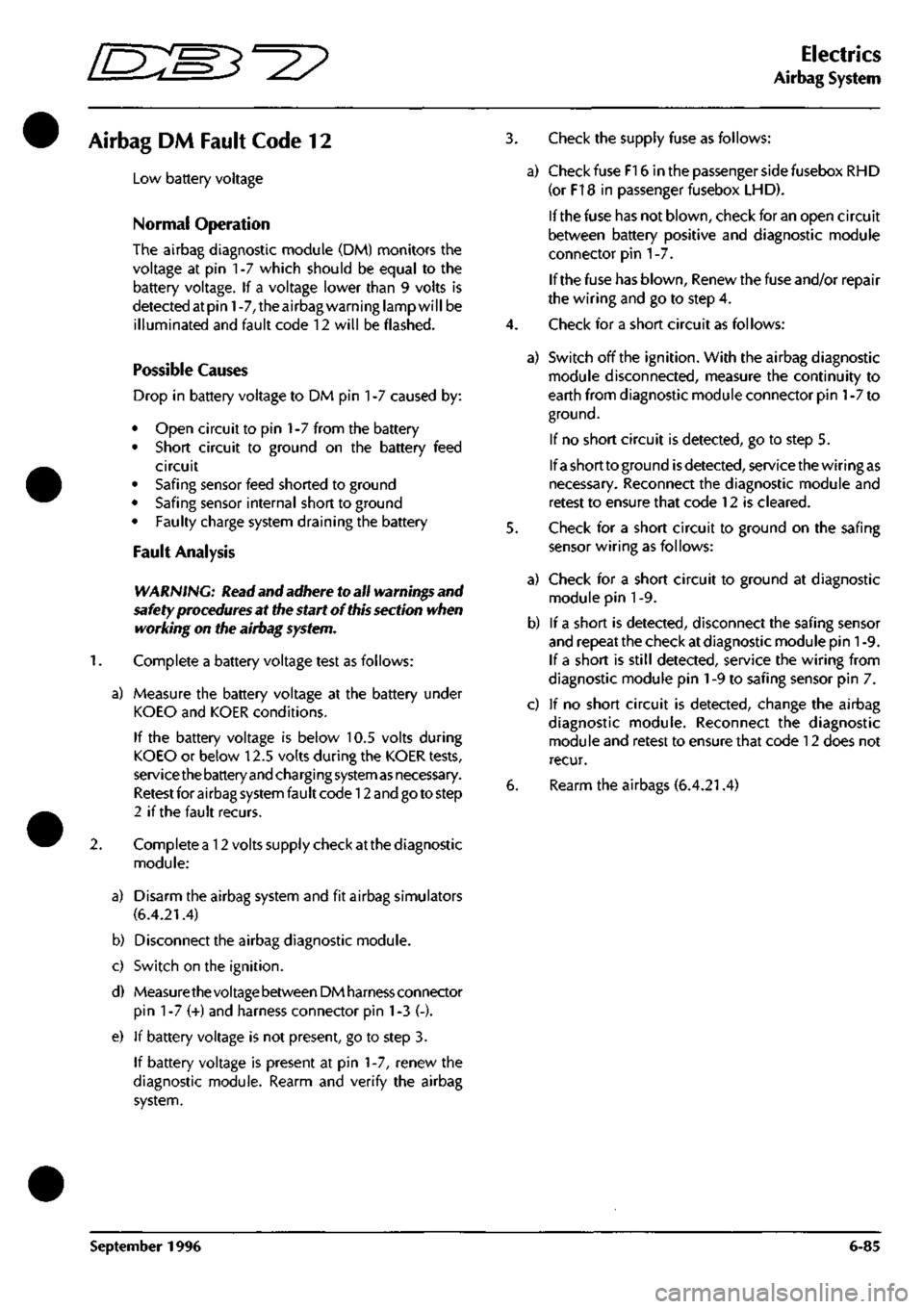
^^?
Electrics
Airbag System
Airbag DM Fault Code 12
Low battery voltage
Normal Operation
The airbag diagnostic module (DM) monitors the
voltage at pin 1-7 which should be equal to the
battery voltage. If a voltage lower than 9 volts is
detected at pin 1-7, the airbag warning lamp will be
illuminated and fault code 12 will be flashed.
Possible Causes
Drop in battery voltage to DM pin 1-7 caused by:
• Open circuit to pin
1
-7 from the battery
• Short circuit to ground on the battery feed
circuit
• Safing sensor feed shorted to ground
• Safing sensor internal short to ground
• Faulty charge system draining the battery
Fault Analysis
WARNING: Read and adhere to all warnings and
safety procedures at the start of
this
section when
working on the airbag system.
1.
Complete a battery voltage test as follows:
a) Measure the battery voltage at the battery under
KOEO and KOER conditions.
If the battery voltage is below 10.5 volts during
KOEO or below 12.5 volts during the KOER tests,
service the battery
and
charging system
as
necessary.
Retest for airbag system fau
It
code 12 and go to step
2 if the fault recurs.
2.
Complete a 12 volts supply check at the diagnostic
module:
a) Disarm the airbag system and fit airbag simulators
(6.4.21.4)
b) Disconnect the airbag diagnostic module.
c) Switch on the ignition.
d) Measurethevoltagebetween DM hamessconnector
pin 1-7 (+) and harness connector pin 1-3 (-).
e) If battery voltage is not present, go to step 3.
If battery voltage is present at pin 1-7, renew the
diagnostic module. Rearm and verify the airbag
system.
3. Check the supply fuse as follows:
a) Check fuse F16 in the passenger side fusebox RHD
(or F18 in passenger fusebox LHD).
If the fuse has not blown, check for an open circuit
between battery positive and diagnostic module
connector pin
1
-7.
If the fuse has blown. Renew the fuse and/or repair
the wiring and go to step 4.
4.
Check for a short circuit as follows:
a) Switch off the ignition. With the airbag diagnostic
module disconnected, measure the continuity to
earth from diagnostic module connector pin
1
-7 to
ground.
If no short circuit is detected, go to step 5.
Ifashortto ground isdetected, service the wiring as
necessary. Reconnect the diagnostic module and
retest to ensure that code 12 is cleared.
5. Check for a short circuit to ground on the safing
sensor wiring as follows:
a) Check for a short circuit to ground at diagnostic
module pin 1-9.
b) If a short is detected, disconnect the safing sensor
and repeat the check at diagnostic module pin
1
-9.
If a short is still detected, service the wiring from
diagnostic module pin
1
-9 to safing sensor pin 7.
c) If no short circuit is detected, change the airbag
diagnostic module. Reconnect the diagnostic
module and retest to ensure that code 12 does not
recur.
6. Rearm the airbags (6.4.21.4)
September 1996 6-85
Page 202 of 421

Electrics
Airbag System ^2?
Airbag DM Fault Code 13
Airbag circuit short to ground
Normal Operation
The diagnostic modu
le
measures the voltage at pins
2-5 and 2-6. The voltage at these pins is dependant
on charging system voltage as shown in the table
belovi-.
'in 2-5
2.3V
2.4 V
2.5V
2.7V
2.8V
3.0V
3.1V
3.2V
3.4V
3.5V
3.7V
3.8V
4.0V
4.1V
4.3V
Pin 2-6
2.3V
2.4V
2.5V
2.7V
2.8V
3.0V
3.1V
3.2V
3.4V
3.5V
3.7V
3.8V
4.0V
4.1V
4.3V
Charge Volts
9.0V
9.5V
lO.OV
10.5V
11.OV
11.5V
12.0V
12.5V
13.0V
13.5V
14.0V
14.5V
15.0V
15.5V
16.0V
If the diagnostic monitor measures a voltage of 2.0
volts or less on pins 2-5 and 2-6, a fau It code 13 will
be generated and flashed to the instrument pack to
be signalled on the airbag warning lamp. Voltages
as low as 2.0 volts indicate a possible short to
ground in these circuits.
When generating a code 13 the diagnostic module
also generates a signal to blow its own internal
thermal fuse. This action disables the airbag
deployment circuit. The airbag diagnostic module
fuse is non-repairable and the module must be
replaced after repairing the short circuit, if the
voltage at pins 2-5 and 2-6 returns to normal, fault
code 51 (blown thermal fuse) will be stored in
memory.
6.
Fault Analysis
WARNING: Read and adhere to all warnings and
safety procedures at the start of this section when
working on the airbag
system.
Disarm the airbag system and fit airbag simulators
(6.4.21.4)
Disconnect the airbag diagnostic module. Switch
on the ignition.
Measure the continuity to ground at the following
pins on the diagnostic module harness connector:
2-2 Passenger airbag feed
2-3 Passenger airbag return
2-4 Drivers airbag return
2-5 Drivers airbag feed
2-11 Safing sensor feed
If no short circuit is detected, go to step 4.
If
a
short circuit is detected, disconnect the relevant
airbag simulator or the safing sensor and repeat the
continuity measurement to isolate the circuit fault.
Service the wiring or replace the safing sensor as
necessary. Fit a new airbag diagnostic module and
rearm the airbags (6.4.21.4).
Check for intermittent short circuits in the cable
reel cassette. Monitor the continuity to ground at
pins 2-4 and 2-5 whilst rotating the steering from
lock to lock in both directions.
If no short circuit is detected, go to step 5.
If a short circuit is detected, replace the column
switchgear assembly. Fit a new airbag diagnostic
module and rearm the airbags (6.4.21.4).
WARNING: Do not attempt to make any electrical
measurements on the airbag
modules.
Any induced
voltage can
cause
the airbag
to
deploy with the
risk
of personal
injury.
Fit a replacement diagnostic module and
replacement airbag modules.
Caution: Do not refit
the
old
airbag
modules.
They may
be faulty and would
damage the
new diagnostic module.
Rearm the airbag system (6.4.21.4).
6-86 September 1996
Page 203 of 421
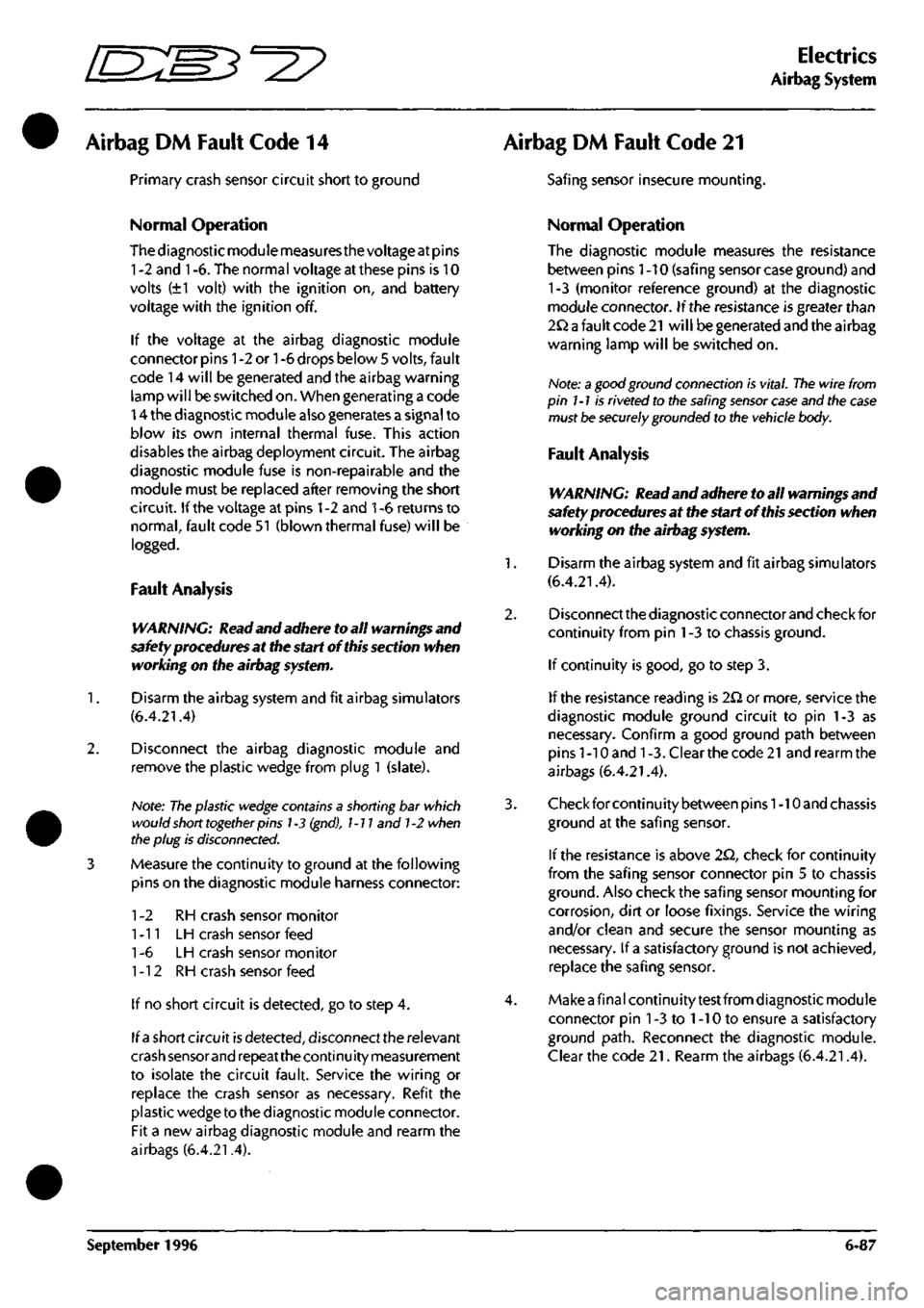
mxm^^^?
Electrics
Airbag System
Airbag DM Fault Code 14
Primary crash sensor circuit short to ground
Airbag DM Fault Code 21
Safing sensor insecure mounting.
Normal Operation
The diagnostic module measuresthevoltage at pins
1
-2 and
1
-6. The normal voltage at these pins is 10
volts (±1 volt) with the ignition on, and battery
voltage with the ignition off.
If the voltage at the airbag diagnostic module
connector pins
1
-2 or
1
-6 drops below 5 volts, fault
code 14 will be generated and the airbag warning
lamp will be switched on. When generating a code
14 the diagnostic module also generates a signal to
blow its own internal thermal fuse. This action
disables the airbag deployment circuit. The airbag
diagnostic module fuse is non-repairable and the
module must be replaced after removing the short
circuit. If the voltage at pins 1-2 and 1-6 returns to
normal,
fault code 51 (blown thermal fuse) will be
logged.
Fault Analysis
WARNING: Read and adhere to all warnings and
safety procedures at the start of
this
section when
working on the airbag system.
1.
Disarm the airbag system and fit airbag simulators
(6.4.21.4)
2.
Disconnect the airbag diagnostic module and
remove the plastic wedge from plug
1
(slate).
Note:
The
plastic wedge contains a shorting bar which
would
short
together pins
1-3
(gnd),
1-11
and 1-2 when
the plug is disconnected.
3 Measure the continuity to ground at the following
pins on the diagnostic module harness connector:
1-2 RH crash sensor monitor
1-11 LH crash sensor feed
1
-6 LH crash sensor monitor
1-12 RH crash sensor feed
If no short circuit is detected, go to step 4.
If a short circuit
is
detected, disconnect the relevant
crash sensorandrepeatthecontinuity measurement
to isolate the circuit fault. Service the wiring or
replace the crash sensor as necessary. Refit the
plastic wedge to the diagnostic module connector.
Fit a new airbag diagnostic module and rearm the
airbags (6.4.21.4).
Normal Operation
The diagnostic module measures the resistance
between pins
1
-10 (safing sensor case ground) and
1-3 (monitor reference ground) at the diagnostic
module connector. If the resistance is greater than
2Q
a
fault code
21
will be generated and the airbag
warning lamp will be switched on.
Note:
a
good ground connection is vital.
The
wire from
pin
1-1
is riveted to the safing
sensor case
and the
case
must
be securely
grounded to the vehicle
body.
Fault Analysis
WARNING: Read and adhere to all warnings and
safety procedures at the start of this section when
working on the airbag system.
Disarm the airbag system and fit airbag simulators
(6.4.21.4).
Disconnect the diagnostic connector and check for
continuity from pin 1-3 to chassis ground.
If continuity is good, go to step 3.
If the resistance reading is 2Q or more, service the
diagnostic module ground circuit to pin 1-3 as
necessary. Confirm a good ground path between
pins 1-10 and 1-3.Clearthecode21 and rearm the
airbags (6.4.21.4).
Check for continuity between pins
1
-10 and chassis
ground at the safing sensor.
If the resistance is above 2Q, check for continuity
from the safing sensor connector pin 5 to chassis
ground.
Also check the safing sensor mounting for
corrosion,
dirt or loose fixings. Service the wiring
and/or clean and secure the sensor mounting as
necessary, if a satisfactory ground is not achieved,
replace the safing sensor.
Make
a
final continuity test from diagnostic module
connector pin
1
-3 to
1
-10 to ensure a satisfactory
ground
path.
Reconnect the diagnostic module.
Clear the code
21.
Rearm the airbags (6.4.21.4).
September 1996 6-87